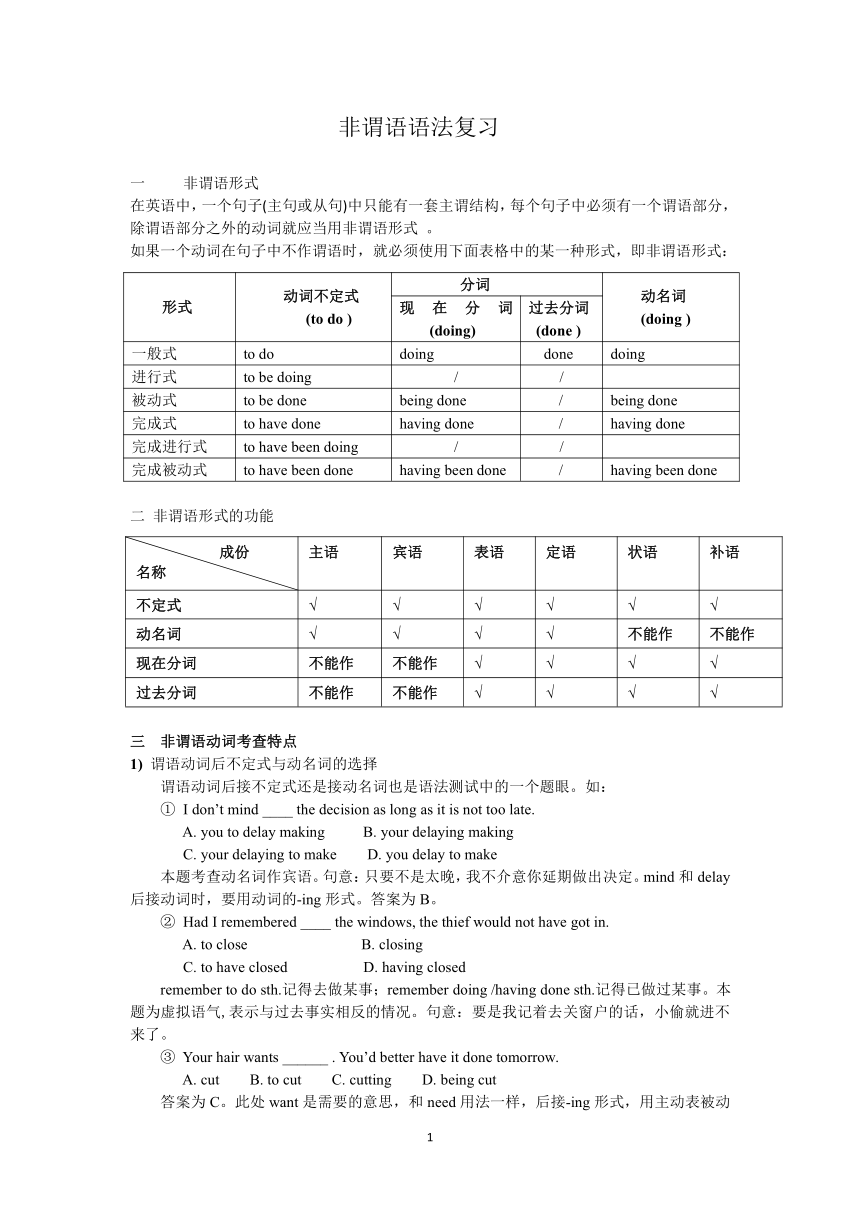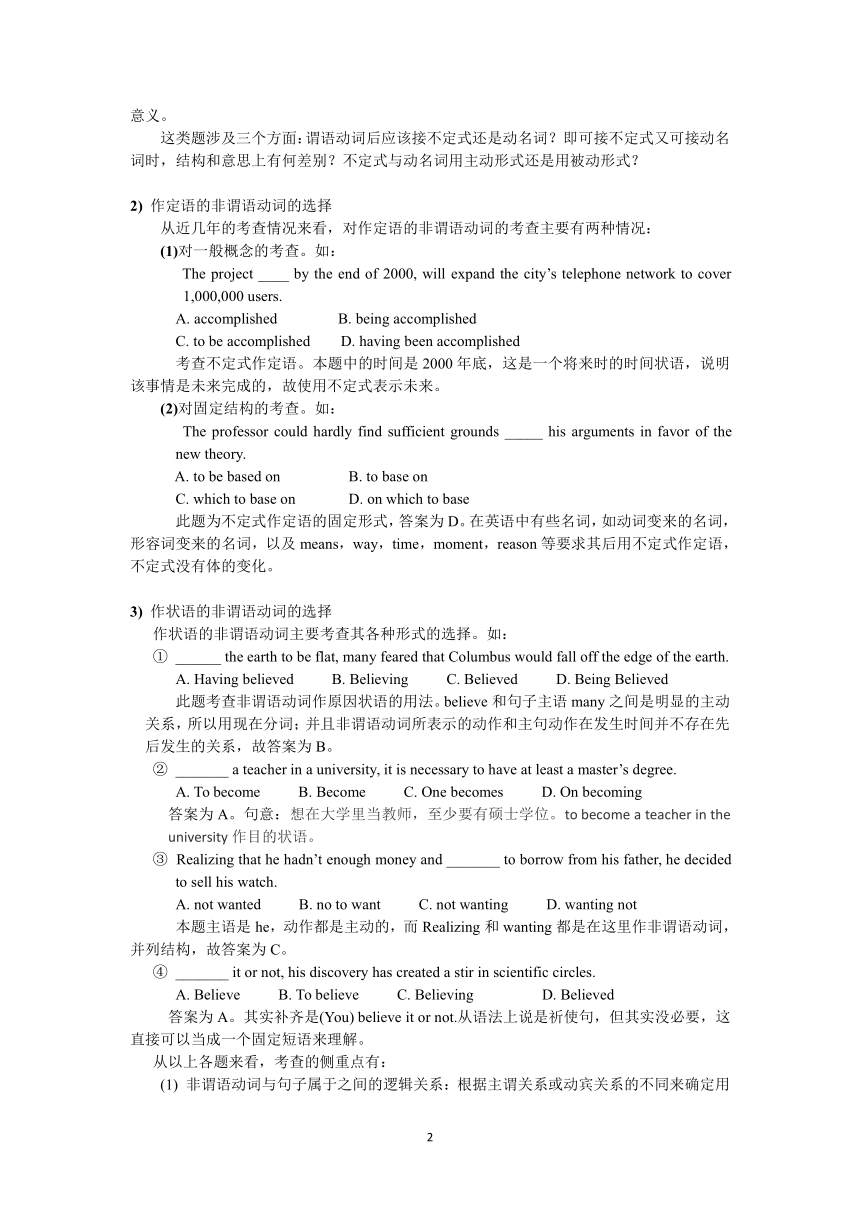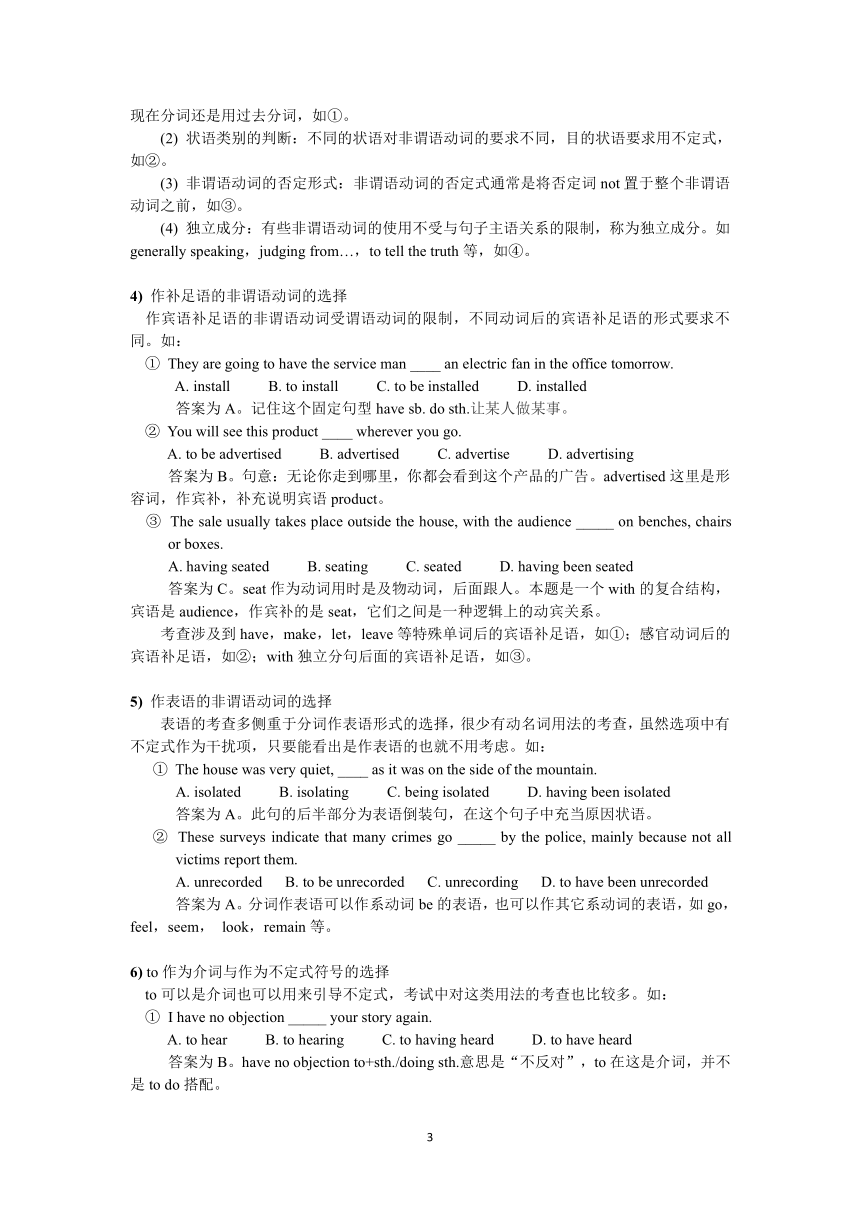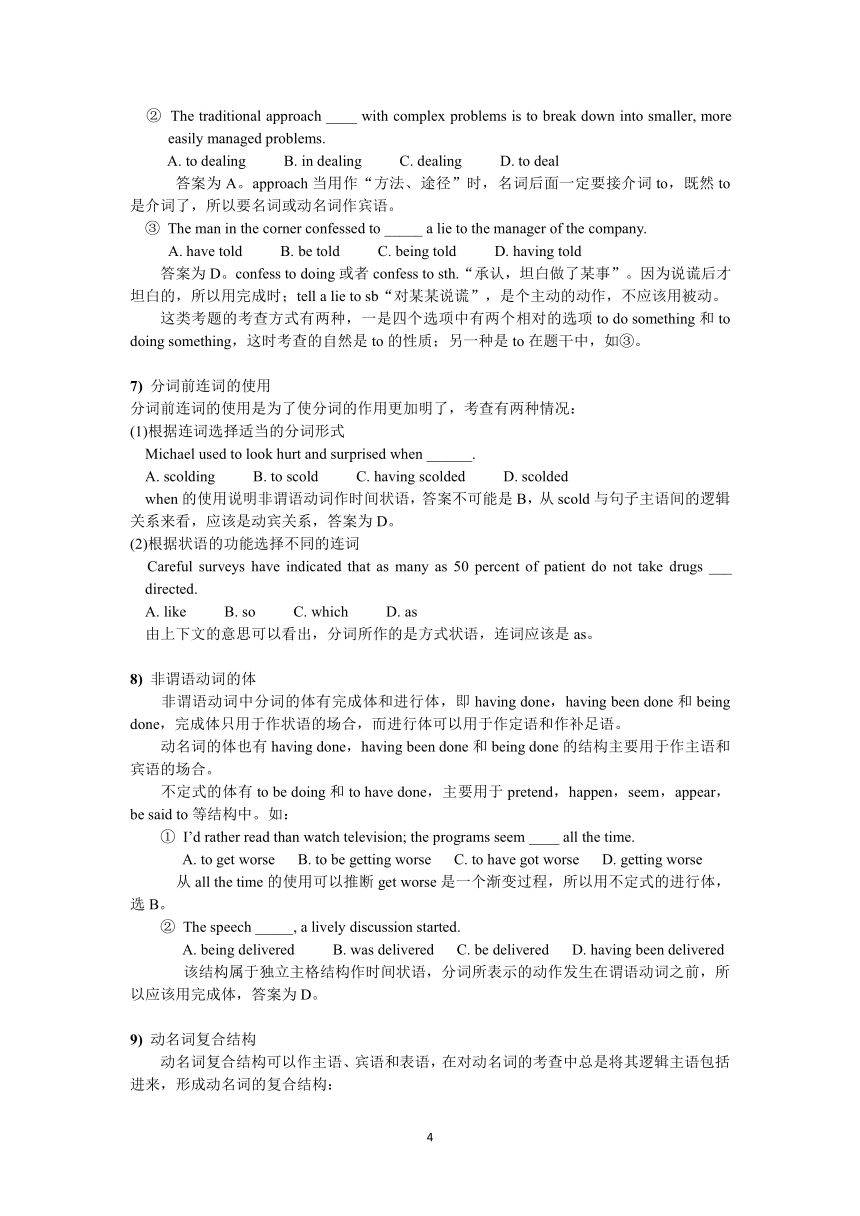高考英语二轮复习之非谓语专题 学案
图片预览




文档简介
非谓语语法复习
一 非谓语形式
在英语中,一个句子(主句或从句)中只能有一套主谓结构,每个句子中必须有一个谓语部分,除谓语部分之外的动词就应当用非谓语形式 。
如果一个动词在句子中不作谓语时,就必须使用下面表格中的某一种形式,即非谓语形式:
形式 动词不定式 (to do ) 分词 动名词 (doing )
现在分词 (doing) 过去分词 (done )
一般式 to do doing done doing
进行式 to be doing / /
被动式 to be done being done / being done
完成式 to have done having done / having done
完成进行式 to have been doing / /
完成被动式 to have been done having been done / having been done
二 非谓语形式的功能
成份 名称 主语 宾语 表语 定语 状语 补语
不定式 √ √ √ √ √ √
动名词 √ √ √ √ 不能作 不能作
现在分词 不能作 不能作 √ √ √ √
过去分词 不能作 不能作 √ √ √ √
三 非谓语动词考查特点
1) 谓语动词后不定式与动名词的选择
谓语动词后接不定式还是接动名词也是语法测试中的一个题眼。如:
① I don’t mind ____ the decision as long as it is not too late.
A. you to delay making B. your delaying making
C. your delaying to make D. you delay to make
本题考查动名词作宾语。句意:只要不是太晚,我不介意你延期做出决定。mind和delay后接动词时,要用动词的-ing形式。答案为B。
② Had I remembered ____ the windows, the thief would not have got in.
A. to close B. closing
C. to have closed D. having closed
remember to do sth.记得去做某事;remember doing /having done sth.记得已做过某事。本题为虚拟语气,表示与过去事实相反的情况。句意:要是我记着去关窗户的话,小偷就进不来了。
③ Your hair wants ______ . You’d better have it done tomorrow.
A. cut B. to cut C. cutting D. being cut
答案为C。此处want是需要的意思,和need用法一样,后接-ing形式,用主动表被动意义。
这类题涉及三个方面:谓语动词后应该接不定式还是动名词?即可接不定式又可接动名词时,结构和意思上有何差别?不定式与动名词用主动形式还是用被动形式?
2) 作定语的非谓语动词的选择
从近几年的考查情况来看,对作定语的非谓语动词的考查主要有两种情况:
(1)对一般概念的考查。如:
The project ____ by the end of 2000, will expand the city’s telephone network to cover 1,000,000 users.
A. accomplished B. being accomplished
C. to be accomplished D. having been accomplished
考查不定式作定语。本题中的时间是2000年底,这是一个将来时的时间状语,说明该事情是未来完成的,故使用不定式表示未来。
(2)对固定结构的考查。如:
The professor could hardly find sufficient grounds _____ his arguments in favor of the new theory.
A. to be based on B. to base on
C. which to base on D. on which to base
此题为不定式作定语的固定形式,答案为D。在英语中有些名词,如动词变来的名词,形容词变来的名词,以及means,way,time,moment,reason等要求其后用不定式作定语,不定式没有体的变化。
3) 作状语的非谓语动词的选择
作状语的非谓语动词主要考查其各种形式的选择。如:
① ______ the earth to be flat, many feared that Columbus would fall off the edge of the earth.
A. Having believed B. Believing C. Believed D. Being Believed
此题考查非谓语动词作原因状语的用法。believe和句子主语many之间是明显的主动关系,所以用现在分词;并且非谓语动词所表示的动作和主句动作在发生时间并不存在先后发生的关系,故答案为B。
② _______ a teacher in a university, it is necessary to have at least a master’s degree.
A. To become B. Become C. One becomes D. On becoming
答案为A。句意:想在大学里当教师,至少要有硕士学位。to become a teacher in the university作目的状语。
③ Realizing that he hadn’t enough money and _______ to borrow from his father, he decided to sell his watch.
A. not wanted B. no to want C. not wanting D. wanting not
本题主语是he,动作都是主动的,而Realizing和wanting都是在这里作非谓语动词,并列结构,故答案为C。
④ _______ it or not, his discovery has created a stir in scientific circles.
A. Believe B. To believe C. Believing D. Believed
答案为A。其实补齐是(You) believe it or not.从语法上说是祈使句,但其实没必要,这直接可以当成一个固定短语来理解。
从以上各题来看,考查的侧重点有:
(1) 非谓语动词与句子属于之间的逻辑关系:根据主谓关系或动宾关系的不同来确定用现在分词还是用过去分词,如①。
(2) 状语类别的判断:不同的状语对非谓语动词的要求不同,目的状语要求用不定式,如②。
(3) 非谓语动词的否定形式:非谓语动词的否定式通常是将否定词not置于整个非谓语动词之前,如③。
(4) 独立成分:有些非谓语动词的使用不受与句子主语关系的限制,称为独立成分。如generally speaking,judging from…,to tell the truth等,如④。
4) 作补足语的非谓语动词的选择
作宾语补足语的非谓语动词受谓语动词的限制,不同动词后的宾语补足语的形式要求不同。如:
① They are going to have the service man ____ an electric fan in the office tomorrow.
A. install B. to install C. to be installed D. installed
答案为A。记住这个固定句型have sb. do sth.让某人做某事。
② You will see this product ____ wherever you go.
A. to be advertised B. advertised C. advertise D. advertising
答案为B。句意:无论你走到哪里,你都会看到这个产品的广告。advertised这里是形容词,作宾补,补充说明宾语product。
③ The sale usually takes place outside the house, with the audience _____ on benches, chairs or boxes.
A. having seated B. seating C. seated D. having been seated
答案为C。seat作为动词用时是及物动词,后面跟人。本题是一个with的复合结构,宾语是audience,作宾补的是seat,它们之间是一种逻辑上的动宾关系。
考查涉及到have,make,let,leave等特殊单词后的宾语补足语,如①;感官动词后的宾语补足语,如②;with独立分句后面的宾语补足语,如③。
5) 作表语的非谓语动词的选择
表语的考查多侧重于分词作表语形式的选择,很少有动名词用法的考查,虽然选项中有不定式作为干扰项,只要能看出是作表语的也就不用考虑。如:
① The house was very quiet, ____ as it was on the side of the mountain.
A. isolated B. isolating C. being isolated D. having been isolated
答案为A。此句的后半部分为表语倒装句,在这个句子中充当原因状语。
② These surveys indicate that many crimes go _____ by the police, mainly because not all victims report them.
A. unrecorded B. to be unrecorded C. unrecording D. to have been unrecorded
答案为A。分词作表语可以作系动词be的表语,也可以作其它系动词的表语,如go,feel,seem, look,remain等。
6) to作为介词与作为不定式符号的选择
to可以是介词也可以用来引导不定式,考试中对这类用法的考查也比较多。如:
① I have no objection _____ your story again.
A. to hear B. to hearing C. to having heard D. to have heard
答案为B。have no objection to+sth./doing sth.意思是“不反对”,to在这是介词,并不是to do搭配。
② The traditional approach ____ with complex problems is to break down into smaller, more easily managed problems.
A. to dealing B. in dealing C. dealing D. to deal
答案为A。approach当用作“方法、途径”时,名词后面一定要接介词to,既然to是介词了,所以要名词或动名词作宾语。
③ The man in the corner confessed to _____ a lie to the manager of the company.
A. have told B. be told C. being told D. having told
答案为D。confess to doing或者confess to sth.“承认,坦白做了某事”。因为说谎后才坦白的,所以用完成时;tell a lie to sb“对某某说谎”,是个主动的动作,不应该用被动。
这类考题的考查方式有两种,一是四个选项中有两个相对的选项to do something和to doing something,这时考查的自然是to的性质;另一种是to在题干中,如③。
7) 分词前连词的使用
分词前连词的使用是为了使分词的作用更加明了,考查有两种情况:
(1)根据连词选择适当的分词形式
Michael used to look hurt and surprised when ______.
A. scolding B. to scold C. having scolded D. scolded
when的使用说明非谓语动词作时间状语,答案不可能是B,从scold与句子主语间的逻辑关系来看,应该是动宾关系,答案为D。
(2)根据状语的功能选择不同的连词
Careful surveys have indicated that as many as 50 percent of patient do not take drugs ___ directed.
A. like B. so C. which D. as
由上下文的意思可以看出,分词所作的是方式状语,连词应该是as。
8) 非谓语动词的体
非谓语动词中分词的体有完成体和进行体,即having done,having been done和being done,完成体只用于作状语的场合,而进行体可以用于作定语和作补足语。
动名词的体也有having done,having been done和being done的结构主要用于作主语和宾语的场合。
不定式的体有to be doing和to have done,主要用于pretend,happen,seem,appear,be said to等结构中。如:
① I’d rather read than watch television; the programs seem ____ all the time.
A. to get worse B. to be getting worse C. to have got worse D. getting worse
从all the time的使用可以推断get worse是一个渐变过程,所以用不定式的进行体,选B。
② The speech _____, a lively discussion started.
A. being delivered B. was delivered C. be delivered D. having been delivered
该结构属于独立主格结构作时间状语,分词所表示的动作发生在谓语动词之前,所以应该用完成体,答案为D。
9) 动名词复合结构
动名词复合结构可以作主语、宾语和表语,在对动名词的考查中总是将其逻辑主语包括进来,形成动名词的复合结构:
① _____ in an atmosphere of simple living was what her parents wished for.
A. The girl was educated B. The girl educated
C. The girl’s being educated D. The girl to be educated
考查非谓语。句意:这个女孩在一种生活简朴的环境中受教育正是她的父母所希望的。该句子缺少主语,动名词复合结构作主语;动名词短语作主语时可以带自己的逻辑主语,用名词或代词所有格来表示。故答案选C。
② I don’t mind _____ the decision as long as it is not too late.
A. you to delay making B. your delaying making
C. you delaying to make D. you delay to make
mind后要求接动名词,动名词的逻辑主语用形容词性物主代词,答案为B。
③ I would appreciate _____ it a secret.
A. your keeping B. you to keep C. that you keep D. that you will keep
本题与上一题类似,答案是A。
四. 非谓语动词解题策略
1) 正确判断非谓语动词
这类题一般出现在独立主格结构中,如果在选项与句子之间没有连词,则说明所选的为独立主格结构,既名词或代词+分词。
All things ______, the planned trip will have to be called off.
A. considered B. be considered C. considering D. having considered
句子没有连词,说明是独立主格作状语;根据动词与其逻辑主语之间的关系为动宾关系,答案为A。
2) 判断动名词复合结构的方式
主语位置上,或动词、介词后的“名词/代词+非谓语动词”,如果表示的是一个事件则是动名词复合结构,而不是“名词+定语”。请看以下各例:
The road _____ caused us to be late for our work for half an hour.
A. blocked B. was blocked C. blocking D. being blocked
主语是表示上班迟到的原因,自然应该是“交通堵塞”,而不是“被堵的道路”,所以是动名词复合结构,答案为D。
The concerned mother thrilled at the news of his son _____ to college.
A. had been admitted B. admitted
C. having been admitted D. having admitted
消息表达的应该是个事件,而不是“被录取的孩子”,介词of后不可能接从句,说明of后为动名词的复合结构,答案是C。
3) 注意分析非谓语动词与其逻辑主语之间的关系
正确判断非谓语动词与其逻辑主语之间的关系是正确选择非谓语动词形式的保证,不管是作什么成分的非谓语动词都体现以下特点:
如果非谓语动词与逻辑主语之间是主谓关系,则用现在分词;如果非谓语动词与逻辑主语之间是动宾关系,则用过去分词;如果表示将来,则用动词不定式。
(1)作定语
作定语的可以是动名词、分词或不定式。动名词作前置定语,所构成的大多为固定短语。主要考查分词和不定式作定语,分词或不定式作定语一般为后置定语。
① The project ____ by the end of 2000, will expand the city’s telephone network to cover 1,000,000 users.
A. accomplished B. being accomplished
C. to be accomplished D. having been accomplished
② Hard work ____ on time will lead to better grades.
A. done B. be done C. having done D. to have been done
③ As early as 1647 Ohio made a decision that free, tax-supported schools must be established in every town _____ 50 households or more.
A. having B. to have C. to have had D. having had
④ Those _____ to the conference were mostly famous scientists.
A. invited B. were invited C. inviting D. to invite
作定语的非谓语动词有一下几种形式:
“doing结构”:分词与中心词之间是主谓关系,表示正在进行或状态,如③
“being done结构”:分词与中心词之间是动宾关系,表示被动和正在进行,如:No one is allowed to enter the building being repaired.
“to be done结构”:不定式与中心词之间是动宾关系,表示将来和被动,如①。
“done结构”:分词与中心词之间是动宾关系,表示被动、完成,如②④。
“to do结构”:不定式与中心词之间是主谓关系,表示将来。如:The professor to give us a speech tomorrow is said to have compiled many scientific works.
答案① C ② A ③ A ④ D
(2)作状语
作状语的可以是不定式,也可以是分词。大体结构有:
“doing结构”:分词与句子主语为主谓关系,表示与谓语动词同时发生,或是同时存在的状态。如:
______ the earth to be flat, many feared that Columbus would fall off the edge of the earth.
A. Having believed B. Believing C. Believed D. Being believed
“done结构”:只要分词与句子主语间是动宾关系就可以用过去分词,可以表示时间、条件、原因、让步或伴随情况等。如:
He came in, followed by a group of reporters.
_______ in this way, the situation doesn’t seem so disappointing.
A. Too look at B. Looking at C. Looked at D. To be looked at
“having done结构”:分词与句子主语是主谓关系,且发生在谓语动词之前。如:Having seen the film already, I declined his invitation to go to the cinema.
“having been done结构”:该结构表示完成被动,即分词与句子主语之间是动宾关系,且发生在谓语动词之前。如:Having been showed many times, he still didn’t understand the operation of the machine.
“to do结构”:这是不定式结构,在句中可以作目的状语,也可以作结果状语。如:
______ this soup, you’ll need two eggs and some mushroom.
A. Having made B. Make C. To make D. Making
表结果时一般为固定结构,如too…to…,enough to….,或是表示出乎意料的结果,常可加构成only to的结构。如:
I did what I could to comfort her only to make her cry even more.
“being done结构”:该结构表示被动与正在进行,一般置于句首,表示原因。如:Being chased by some spies, he hid himself in the grass.
(3)作表语
对表语的考查主要侧重在现在分词与过去分词的区别上。现在分词作表语:一般表示主动或主语的性质和特征。含有“令人……”的意思。主语多数情况下是物。过去分词作表语:一般表示被动或主语所处的状态。含有“感到……”的意思。主语多数情况下是人。
The news sounds encouraging!
— How did the audience receive the new play?
— They got very excited.
(4)作宾语补足语
一般作宾补的非谓语动词的选择与其它成分中的非谓语动词形式选择规则基本相同。 doing结构:分词与宾语构成主谓关系,表示正在进行。
When I caught him ____ me I stopped buying things there and started dealing with another shop.
A. cheating B. cheat C. to cheat D. to be cheating
done结构:分词与宾语构成动宾关系,表示被动与完成。
Don’t get your schedule _____; stay with us in this class.
A. to change B. changing C. changed D. change
to do结构:不定式表示将来,如:wish somebody to do, expect somebody to do等。
4) 熟记固定搭配,分清不定式与to加动名词。
其实容易产生不定式符号与介词混淆的只是为数不多的某些句式,只要平时注意积累即可:
prefer doing sth. to doing sth.
look forward to doing sth.
be used to doing sth. (习惯于做某事)
stick to doing sth.
object to doing sth./ have objection to doing sth.
be opposed to doing sth.
admit/confess to doing sth.
5) 分清宾补的类别
(1) 感官动词后的宾补可以是doing,do,done和being done结构。
(2) have sb. do sth.让某人做某事
have sb. doing sth. 让某人一直做某事
have sth. done 使某事被做
(3) catch,keep,set等只能接doing的结构,表示主动和正在进行。
(4) leave sb. doing sth.让某人一直做某事
(5) with sth. to do sth.宾补与宾语之间是主谓关系,表示将来。
with sb. doing sth.宾补与宾语之间是主谓关系,表示正在进行。
with sth. done宾补与宾语之间是动宾关系,表示完成。
五 常见用法及搭配
不定式(带to)
V+ to do
pretend, demand(要求), long, care, choose, dare, fail, desire, appear, intend, offer(主动提出),
apply (申请), neglect , arrange
Sb be done to do ---
Sb be said/believed/known/reported/considered/found /thought/acknowledged to do/ to be doing /to have done
3、would like to → should love/like to do ;
intend, mean, want, plan…
the +序数词/last/only +(n) + to do
sb/sth. be adj. to do ; it形式宾语/主语
to be honest/ frank, to tell the truth, to be sure, to begin/start with , to conclude/summarize
only to do, in order to do, so as to do, so(such)… as to
(二)不定式(不带to)
1. V+ O+ do (注意:一感二听三让四看)
2. Why not do …
(三)动名词
1、V+ doing
appreciate, stand, bear, deny, oppose, escape, risk,admit, delay, resist, avoid, quit , acknowledge ,
permit, imagine, postpone, include---
2、Prep +doing
3、固定句型
have a hard time (in) doing;
have difficulty/trouble (in) doing;
feel like doing;
It’s no use/good doing… ;
There’s no sense/point (in) doing…
4、动词+to作介词+动名词
object to doing sth. 反对做某事?
see to doing sth. 负责做某事?
stick to doing sth. 坚持做某事?
take to doing sth. 喜欢上做某事,逐渐习惯做某事
5. 动词+宾语+介词to+动名词?
apply oneself to doing sth. 专心致力于做某事?
devote sth. to doing sth. 把……献给做某事?
devote oneself to doing sth. 献身于做某事?
limit sth. to doing sth. 把……限制在做某事的范围内?
reduce sb/oneself. to doing sth. 使某人沦为做某事
have an eye to doing sth. 注意做某事?
have an objection to doing sth. 反对(反感)做某事?
pay attention to doing sth. 注意做某事?
6.be+形容词+介词to+动名词?
(1) be equal to doing sth. 等于做某事,能胜任做某事?
(2) be used to doing sth. 习惯于做某事?
(3) be opposed to doing sth. 反对做某事?
(4) be reduced to doing sth. 使某人沦为做某事?
(5) be devoted to doing sth. 把时间(钱,精力等)献给做某事?
(6) be limited to doing sth. 把……限制在做某事的范围内?
7.其他结构+介词to+动名词?
(1) get down to doing sth. 开始做某事,认真处理某事?
(2) look forward to doing sth. 盼望做某事?
补充
1.remember/ forget; regret; mean; try; can’t help ; go on/advise / allow / permit / forbid后既可跟doing sth.作宾语,又可跟to do(不定式作宾补),
2. need, require, want, deserve +doing 动名词的主动形式表被动意义,相当于to be done,
3. 特例:Generally / Frankly / Strictly speaking ;
Judging from / by ….;
Considering… ; Allowing for…; Given…;
Talking about / Speaking of ….
Supposing/suppose that. . . 假定;
Providing/provided that. . . 假定……
4.部分过去分词来源于系表结构,作状语时不表示被动关系,
其前不用being。这样的过去分词及短语常见的有:
seated(坐着的)、hidden(躲着)、stationed(驻扎)、
lost/absorbed in(沉溺于)、born in(出身于)、
dressed in(穿着)、tired of(厌烦了)等。
六、总结:非谓语动词解题方法三步走
第一步:(成分判断)判断非谓语动词充当的句子成分?
第二步:(语态判断)判断主动、被动语态
第三步:(时态判断)判断非谓语动词的动作与谓语动作的先后关系
一 非谓语形式
在英语中,一个句子(主句或从句)中只能有一套主谓结构,每个句子中必须有一个谓语部分,除谓语部分之外的动词就应当用非谓语形式 。
如果一个动词在句子中不作谓语时,就必须使用下面表格中的某一种形式,即非谓语形式:
形式 动词不定式 (to do ) 分词 动名词 (doing )
现在分词 (doing) 过去分词 (done )
一般式 to do doing done doing
进行式 to be doing / /
被动式 to be done being done / being done
完成式 to have done having done / having done
完成进行式 to have been doing / /
完成被动式 to have been done having been done / having been done
二 非谓语形式的功能
成份 名称 主语 宾语 表语 定语 状语 补语
不定式 √ √ √ √ √ √
动名词 √ √ √ √ 不能作 不能作
现在分词 不能作 不能作 √ √ √ √
过去分词 不能作 不能作 √ √ √ √
三 非谓语动词考查特点
1) 谓语动词后不定式与动名词的选择
谓语动词后接不定式还是接动名词也是语法测试中的一个题眼。如:
① I don’t mind ____ the decision as long as it is not too late.
A. you to delay making B. your delaying making
C. your delaying to make D. you delay to make
本题考查动名词作宾语。句意:只要不是太晚,我不介意你延期做出决定。mind和delay后接动词时,要用动词的-ing形式。答案为B。
② Had I remembered ____ the windows, the thief would not have got in.
A. to close B. closing
C. to have closed D. having closed
remember to do sth.记得去做某事;remember doing /having done sth.记得已做过某事。本题为虚拟语气,表示与过去事实相反的情况。句意:要是我记着去关窗户的话,小偷就进不来了。
③ Your hair wants ______ . You’d better have it done tomorrow.
A. cut B. to cut C. cutting D. being cut
答案为C。此处want是需要的意思,和need用法一样,后接-ing形式,用主动表被动意义。
这类题涉及三个方面:谓语动词后应该接不定式还是动名词?即可接不定式又可接动名词时,结构和意思上有何差别?不定式与动名词用主动形式还是用被动形式?
2) 作定语的非谓语动词的选择
从近几年的考查情况来看,对作定语的非谓语动词的考查主要有两种情况:
(1)对一般概念的考查。如:
The project ____ by the end of 2000, will expand the city’s telephone network to cover 1,000,000 users.
A. accomplished B. being accomplished
C. to be accomplished D. having been accomplished
考查不定式作定语。本题中的时间是2000年底,这是一个将来时的时间状语,说明该事情是未来完成的,故使用不定式表示未来。
(2)对固定结构的考查。如:
The professor could hardly find sufficient grounds _____ his arguments in favor of the new theory.
A. to be based on B. to base on
C. which to base on D. on which to base
此题为不定式作定语的固定形式,答案为D。在英语中有些名词,如动词变来的名词,形容词变来的名词,以及means,way,time,moment,reason等要求其后用不定式作定语,不定式没有体的变化。
3) 作状语的非谓语动词的选择
作状语的非谓语动词主要考查其各种形式的选择。如:
① ______ the earth to be flat, many feared that Columbus would fall off the edge of the earth.
A. Having believed B. Believing C. Believed D. Being Believed
此题考查非谓语动词作原因状语的用法。believe和句子主语many之间是明显的主动关系,所以用现在分词;并且非谓语动词所表示的动作和主句动作在发生时间并不存在先后发生的关系,故答案为B。
② _______ a teacher in a university, it is necessary to have at least a master’s degree.
A. To become B. Become C. One becomes D. On becoming
答案为A。句意:想在大学里当教师,至少要有硕士学位。to become a teacher in the university作目的状语。
③ Realizing that he hadn’t enough money and _______ to borrow from his father, he decided to sell his watch.
A. not wanted B. no to want C. not wanting D. wanting not
本题主语是he,动作都是主动的,而Realizing和wanting都是在这里作非谓语动词,并列结构,故答案为C。
④ _______ it or not, his discovery has created a stir in scientific circles.
A. Believe B. To believe C. Believing D. Believed
答案为A。其实补齐是(You) believe it or not.从语法上说是祈使句,但其实没必要,这直接可以当成一个固定短语来理解。
从以上各题来看,考查的侧重点有:
(1) 非谓语动词与句子属于之间的逻辑关系:根据主谓关系或动宾关系的不同来确定用现在分词还是用过去分词,如①。
(2) 状语类别的判断:不同的状语对非谓语动词的要求不同,目的状语要求用不定式,如②。
(3) 非谓语动词的否定形式:非谓语动词的否定式通常是将否定词not置于整个非谓语动词之前,如③。
(4) 独立成分:有些非谓语动词的使用不受与句子主语关系的限制,称为独立成分。如generally speaking,judging from…,to tell the truth等,如④。
4) 作补足语的非谓语动词的选择
作宾语补足语的非谓语动词受谓语动词的限制,不同动词后的宾语补足语的形式要求不同。如:
① They are going to have the service man ____ an electric fan in the office tomorrow.
A. install B. to install C. to be installed D. installed
答案为A。记住这个固定句型have sb. do sth.让某人做某事。
② You will see this product ____ wherever you go.
A. to be advertised B. advertised C. advertise D. advertising
答案为B。句意:无论你走到哪里,你都会看到这个产品的广告。advertised这里是形容词,作宾补,补充说明宾语product。
③ The sale usually takes place outside the house, with the audience _____ on benches, chairs or boxes.
A. having seated B. seating C. seated D. having been seated
答案为C。seat作为动词用时是及物动词,后面跟人。本题是一个with的复合结构,宾语是audience,作宾补的是seat,它们之间是一种逻辑上的动宾关系。
考查涉及到have,make,let,leave等特殊单词后的宾语补足语,如①;感官动词后的宾语补足语,如②;with独立分句后面的宾语补足语,如③。
5) 作表语的非谓语动词的选择
表语的考查多侧重于分词作表语形式的选择,很少有动名词用法的考查,虽然选项中有不定式作为干扰项,只要能看出是作表语的也就不用考虑。如:
① The house was very quiet, ____ as it was on the side of the mountain.
A. isolated B. isolating C. being isolated D. having been isolated
答案为A。此句的后半部分为表语倒装句,在这个句子中充当原因状语。
② These surveys indicate that many crimes go _____ by the police, mainly because not all victims report them.
A. unrecorded B. to be unrecorded C. unrecording D. to have been unrecorded
答案为A。分词作表语可以作系动词be的表语,也可以作其它系动词的表语,如go,feel,seem, look,remain等。
6) to作为介词与作为不定式符号的选择
to可以是介词也可以用来引导不定式,考试中对这类用法的考查也比较多。如:
① I have no objection _____ your story again.
A. to hear B. to hearing C. to having heard D. to have heard
答案为B。have no objection to+sth./doing sth.意思是“不反对”,to在这是介词,并不是to do搭配。
② The traditional approach ____ with complex problems is to break down into smaller, more easily managed problems.
A. to dealing B. in dealing C. dealing D. to deal
答案为A。approach当用作“方法、途径”时,名词后面一定要接介词to,既然to是介词了,所以要名词或动名词作宾语。
③ The man in the corner confessed to _____ a lie to the manager of the company.
A. have told B. be told C. being told D. having told
答案为D。confess to doing或者confess to sth.“承认,坦白做了某事”。因为说谎后才坦白的,所以用完成时;tell a lie to sb“对某某说谎”,是个主动的动作,不应该用被动。
这类考题的考查方式有两种,一是四个选项中有两个相对的选项to do something和to doing something,这时考查的自然是to的性质;另一种是to在题干中,如③。
7) 分词前连词的使用
分词前连词的使用是为了使分词的作用更加明了,考查有两种情况:
(1)根据连词选择适当的分词形式
Michael used to look hurt and surprised when ______.
A. scolding B. to scold C. having scolded D. scolded
when的使用说明非谓语动词作时间状语,答案不可能是B,从scold与句子主语间的逻辑关系来看,应该是动宾关系,答案为D。
(2)根据状语的功能选择不同的连词
Careful surveys have indicated that as many as 50 percent of patient do not take drugs ___ directed.
A. like B. so C. which D. as
由上下文的意思可以看出,分词所作的是方式状语,连词应该是as。
8) 非谓语动词的体
非谓语动词中分词的体有完成体和进行体,即having done,having been done和being done,完成体只用于作状语的场合,而进行体可以用于作定语和作补足语。
动名词的体也有having done,having been done和being done的结构主要用于作主语和宾语的场合。
不定式的体有to be doing和to have done,主要用于pretend,happen,seem,appear,be said to等结构中。如:
① I’d rather read than watch television; the programs seem ____ all the time.
A. to get worse B. to be getting worse C. to have got worse D. getting worse
从all the time的使用可以推断get worse是一个渐变过程,所以用不定式的进行体,选B。
② The speech _____, a lively discussion started.
A. being delivered B. was delivered C. be delivered D. having been delivered
该结构属于独立主格结构作时间状语,分词所表示的动作发生在谓语动词之前,所以应该用完成体,答案为D。
9) 动名词复合结构
动名词复合结构可以作主语、宾语和表语,在对动名词的考查中总是将其逻辑主语包括进来,形成动名词的复合结构:
① _____ in an atmosphere of simple living was what her parents wished for.
A. The girl was educated B. The girl educated
C. The girl’s being educated D. The girl to be educated
考查非谓语。句意:这个女孩在一种生活简朴的环境中受教育正是她的父母所希望的。该句子缺少主语,动名词复合结构作主语;动名词短语作主语时可以带自己的逻辑主语,用名词或代词所有格来表示。故答案选C。
② I don’t mind _____ the decision as long as it is not too late.
A. you to delay making B. your delaying making
C. you delaying to make D. you delay to make
mind后要求接动名词,动名词的逻辑主语用形容词性物主代词,答案为B。
③ I would appreciate _____ it a secret.
A. your keeping B. you to keep C. that you keep D. that you will keep
本题与上一题类似,答案是A。
四. 非谓语动词解题策略
1) 正确判断非谓语动词
这类题一般出现在独立主格结构中,如果在选项与句子之间没有连词,则说明所选的为独立主格结构,既名词或代词+分词。
All things ______, the planned trip will have to be called off.
A. considered B. be considered C. considering D. having considered
句子没有连词,说明是独立主格作状语;根据动词与其逻辑主语之间的关系为动宾关系,答案为A。
2) 判断动名词复合结构的方式
主语位置上,或动词、介词后的“名词/代词+非谓语动词”,如果表示的是一个事件则是动名词复合结构,而不是“名词+定语”。请看以下各例:
The road _____ caused us to be late for our work for half an hour.
A. blocked B. was blocked C. blocking D. being blocked
主语是表示上班迟到的原因,自然应该是“交通堵塞”,而不是“被堵的道路”,所以是动名词复合结构,答案为D。
The concerned mother thrilled at the news of his son _____ to college.
A. had been admitted B. admitted
C. having been admitted D. having admitted
消息表达的应该是个事件,而不是“被录取的孩子”,介词of后不可能接从句,说明of后为动名词的复合结构,答案是C。
3) 注意分析非谓语动词与其逻辑主语之间的关系
正确判断非谓语动词与其逻辑主语之间的关系是正确选择非谓语动词形式的保证,不管是作什么成分的非谓语动词都体现以下特点:
如果非谓语动词与逻辑主语之间是主谓关系,则用现在分词;如果非谓语动词与逻辑主语之间是动宾关系,则用过去分词;如果表示将来,则用动词不定式。
(1)作定语
作定语的可以是动名词、分词或不定式。动名词作前置定语,所构成的大多为固定短语。主要考查分词和不定式作定语,分词或不定式作定语一般为后置定语。
① The project ____ by the end of 2000, will expand the city’s telephone network to cover 1,000,000 users.
A. accomplished B. being accomplished
C. to be accomplished D. having been accomplished
② Hard work ____ on time will lead to better grades.
A. done B. be done C. having done D. to have been done
③ As early as 1647 Ohio made a decision that free, tax-supported schools must be established in every town _____ 50 households or more.
A. having B. to have C. to have had D. having had
④ Those _____ to the conference were mostly famous scientists.
A. invited B. were invited C. inviting D. to invite
作定语的非谓语动词有一下几种形式:
“doing结构”:分词与中心词之间是主谓关系,表示正在进行或状态,如③
“being done结构”:分词与中心词之间是动宾关系,表示被动和正在进行,如:No one is allowed to enter the building being repaired.
“to be done结构”:不定式与中心词之间是动宾关系,表示将来和被动,如①。
“done结构”:分词与中心词之间是动宾关系,表示被动、完成,如②④。
“to do结构”:不定式与中心词之间是主谓关系,表示将来。如:The professor to give us a speech tomorrow is said to have compiled many scientific works.
答案① C ② A ③ A ④ D
(2)作状语
作状语的可以是不定式,也可以是分词。大体结构有:
“doing结构”:分词与句子主语为主谓关系,表示与谓语动词同时发生,或是同时存在的状态。如:
______ the earth to be flat, many feared that Columbus would fall off the edge of the earth.
A. Having believed B. Believing C. Believed D. Being believed
“done结构”:只要分词与句子主语间是动宾关系就可以用过去分词,可以表示时间、条件、原因、让步或伴随情况等。如:
He came in, followed by a group of reporters.
_______ in this way, the situation doesn’t seem so disappointing.
A. Too look at B. Looking at C. Looked at D. To be looked at
“having done结构”:分词与句子主语是主谓关系,且发生在谓语动词之前。如:Having seen the film already, I declined his invitation to go to the cinema.
“having been done结构”:该结构表示完成被动,即分词与句子主语之间是动宾关系,且发生在谓语动词之前。如:Having been showed many times, he still didn’t understand the operation of the machine.
“to do结构”:这是不定式结构,在句中可以作目的状语,也可以作结果状语。如:
______ this soup, you’ll need two eggs and some mushroom.
A. Having made B. Make C. To make D. Making
表结果时一般为固定结构,如too…to…,enough to….,或是表示出乎意料的结果,常可加构成only to的结构。如:
I did what I could to comfort her only to make her cry even more.
“being done结构”:该结构表示被动与正在进行,一般置于句首,表示原因。如:Being chased by some spies, he hid himself in the grass.
(3)作表语
对表语的考查主要侧重在现在分词与过去分词的区别上。现在分词作表语:一般表示主动或主语的性质和特征。含有“令人……”的意思。主语多数情况下是物。过去分词作表语:一般表示被动或主语所处的状态。含有“感到……”的意思。主语多数情况下是人。
The news sounds encouraging!
— How did the audience receive the new play?
— They got very excited.
(4)作宾语补足语
一般作宾补的非谓语动词的选择与其它成分中的非谓语动词形式选择规则基本相同。 doing结构:分词与宾语构成主谓关系,表示正在进行。
When I caught him ____ me I stopped buying things there and started dealing with another shop.
A. cheating B. cheat C. to cheat D. to be cheating
done结构:分词与宾语构成动宾关系,表示被动与完成。
Don’t get your schedule _____; stay with us in this class.
A. to change B. changing C. changed D. change
to do结构:不定式表示将来,如:wish somebody to do, expect somebody to do等。
4) 熟记固定搭配,分清不定式与to加动名词。
其实容易产生不定式符号与介词混淆的只是为数不多的某些句式,只要平时注意积累即可:
prefer doing sth. to doing sth.
look forward to doing sth.
be used to doing sth. (习惯于做某事)
stick to doing sth.
object to doing sth./ have objection to doing sth.
be opposed to doing sth.
admit/confess to doing sth.
5) 分清宾补的类别
(1) 感官动词后的宾补可以是doing,do,done和being done结构。
(2) have sb. do sth.让某人做某事
have sb. doing sth. 让某人一直做某事
have sth. done 使某事被做
(3) catch,keep,set等只能接doing的结构,表示主动和正在进行。
(4) leave sb. doing sth.让某人一直做某事
(5) with sth. to do sth.宾补与宾语之间是主谓关系,表示将来。
with sb. doing sth.宾补与宾语之间是主谓关系,表示正在进行。
with sth. done宾补与宾语之间是动宾关系,表示完成。
五 常见用法及搭配
不定式(带to)
V+ to do
pretend, demand(要求), long, care, choose, dare, fail, desire, appear, intend, offer(主动提出),
apply (申请), neglect , arrange
Sb be done to do ---
Sb be said/believed/known/reported/considered/found /thought/acknowledged to do/ to be doing /to have done
3、would like to → should love/like to do ;
intend, mean, want, plan…
the +序数词/last/only +(n) + to do
sb/sth. be adj. to do ; it形式宾语/主语
to be honest/ frank, to tell the truth, to be sure, to begin/start with , to conclude/summarize
only to do, in order to do, so as to do, so(such)… as to
(二)不定式(不带to)
1. V+ O+ do (注意:一感二听三让四看)
2. Why not do …
(三)动名词
1、V+ doing
appreciate, stand, bear, deny, oppose, escape, risk,admit, delay, resist, avoid, quit , acknowledge ,
permit, imagine, postpone, include---
2、Prep +doing
3、固定句型
have a hard time (in) doing;
have difficulty/trouble (in) doing;
feel like doing;
It’s no use/good doing… ;
There’s no sense/point (in) doing…
4、动词+to作介词+动名词
object to doing sth. 反对做某事?
see to doing sth. 负责做某事?
stick to doing sth. 坚持做某事?
take to doing sth. 喜欢上做某事,逐渐习惯做某事
5. 动词+宾语+介词to+动名词?
apply oneself to doing sth. 专心致力于做某事?
devote sth. to doing sth. 把……献给做某事?
devote oneself to doing sth. 献身于做某事?
limit sth. to doing sth. 把……限制在做某事的范围内?
reduce sb/oneself. to doing sth. 使某人沦为做某事
have an eye to doing sth. 注意做某事?
have an objection to doing sth. 反对(反感)做某事?
pay attention to doing sth. 注意做某事?
6.be+形容词+介词to+动名词?
(1) be equal to doing sth. 等于做某事,能胜任做某事?
(2) be used to doing sth. 习惯于做某事?
(3) be opposed to doing sth. 反对做某事?
(4) be reduced to doing sth. 使某人沦为做某事?
(5) be devoted to doing sth. 把时间(钱,精力等)献给做某事?
(6) be limited to doing sth. 把……限制在做某事的范围内?
7.其他结构+介词to+动名词?
(1) get down to doing sth. 开始做某事,认真处理某事?
(2) look forward to doing sth. 盼望做某事?
补充
1.remember/ forget; regret; mean; try; can’t help ; go on/advise / allow / permit / forbid后既可跟doing sth.作宾语,又可跟to do(不定式作宾补),
2. need, require, want, deserve +doing 动名词的主动形式表被动意义,相当于to be done,
3. 特例:Generally / Frankly / Strictly speaking ;
Judging from / by ….;
Considering… ; Allowing for…; Given…;
Talking about / Speaking of ….
Supposing/suppose that. . . 假定;
Providing/provided that. . . 假定……
4.部分过去分词来源于系表结构,作状语时不表示被动关系,
其前不用being。这样的过去分词及短语常见的有:
seated(坐着的)、hidden(躲着)、stationed(驻扎)、
lost/absorbed in(沉溺于)、born in(出身于)、
dressed in(穿着)、tired of(厌烦了)等。
六、总结:非谓语动词解题方法三步走
第一步:(成分判断)判断非谓语动词充当的句子成分?
第二步:(语态判断)判断主动、被动语态
第三步:(时态判断)判断非谓语动词的动作与谓语动作的先后关系
